Dietary Self-Assessment
Contributors:

Suja Sadasuvin, MD
Lauren Oliver, MS, RD, LDN
Gita Rao, MD, MPH
Hannah Milch, MS-IV
Ashley Decker, MS-IV
Carine Lenders, MD, PhD
Kathy Gorman, MS, RD, LDN
Wayne W. LaMorte, MD, PhD, MPH
Nan Harvey, MD
Lorraine Stanfield, MD
Vanessa Supple, BA
Learning Objectives
After successfully completing this module, you will be able to:
- Explain the major recommendations from the US dietary guidelines for adults.
- Provide examples of nutrient- and energy-dense foods.
- Define the difference between portion and serving size.
- Calculate body mass index (BMI).
- Perform a 24-hour diet recall self-assessment.
We gratefully acknowledge support for this project from:
- The New Balance Foundation Award: Medical Education Intervention (Carine Lenders)
- The Clinical Nutrition Internship Award from the ASN (Gita Rao)
Dietary Guidelines for Americans
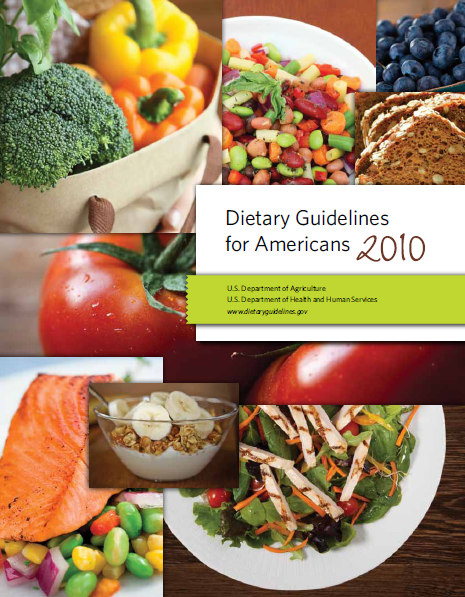 Every five years the Department of Health and Human Services (HHS) and the Department of Agriculture (USDA) issue a report containing nutritional and dietary information and guidelines for the general public over two years of age based on a review of scientific evidence. The aim is to provide advice to promote health and to reduce risk for major chronic diseases through diet and physical activity. A detailed description of the process and the most recent report can be found at http://www.health.gov/dietaryguidelines/2010.asp
Every five years the Department of Health and Human Services (HHS) and the Department of Agriculture (USDA) issue a report containing nutritional and dietary information and guidelines for the general public over two years of age based on a review of scientific evidence. The aim is to provide advice to promote health and to reduce risk for major chronic diseases through diet and physical activity. A detailed description of the process and the most recent report can be found at http://www.health.gov/dietaryguidelines/2010.asp
From the www.health.gov web site:
"The Dietary Guidelines for Americans, 2010, released on January 31, 2011, emphasize three major goals for Americans:
- Balance calories with physical activity to manage weight
- Consume more of certain foods and nutrients such as fruits, vegetables, whole grains, fat-free and low-fat dairy products, and seafood
- Consume fewer foods with sodium (salt), saturated fats, trans fats, cholesterol, added sugars, and refined grains
The Dietary Guidelines for Americans, 2010 include 23 key recommendations for the general population and 6 additional key recommendations for specific population groups, such as pregnant women. The recommendations are intended to help people choose an overall healthy diet."
Major Recommendations
Manage Weight
- Prevent and/or reduce overweight and obesity through improved eating and physical activity behaviors.
- Control total calorie intake to manage body weight. For people who are overweight or obese, this will mean consuming fewer calories from foods and beverages.
- Increase physical activity and reduce time spent in sedentary behaviors.
- Maintain appropriate calorie balance during each stage of life - childhood, adolescence, adulthood, pregnancy and breastfeeding, and older age.
Foods and Food Components to Reduce
- Reduce daily sodium intake to less than 2,300 milligrams (mg) and further reduce intake to 1,500 mg among persons who are 51 and older and those of any age who are African American or have hypertension, diabetes, or chronic kidney disease. The 1,500 mg recommendation applies to about half of the U.S. population, including children, and the majority of adults.
- Consume less than 10 percent of calories from saturated fatty acids by replacing them with monounsaturated and polyunsaturated fatty acids.
- Consume less than 300 mg per day of dietary cholesterol.
- Keep trans fatty acid consumption as low as possible by limiting foods that contain synthetic sources of trans fats, such as partially hydrogenated oils, and by limiting other solid fats.
- Reduce the intake of calories from solid fats and added sugars.
- Limit the consumption of foods that contain refined grains, especially refined grain foods that contain solid fats, added sugars, and sodium.
- If alcohol is consumed, it should be consumed in moderation - up to one drink per day for women and two drinks per day for men—and only by adults of legal drinking age .
Foods and Nutrients to Increase
Individuals should meet the following recommendations as part of a healthy eating pattern while staying within their calorie needs.
- Increase vegetable and fruit intake.
- Eat a variety of vegetables, especially dark-green and red and orange vegetables and beans and peas.
- Consume at least half of all grains as whole grains. Increase whole-grain intake by replacing refined grains with whole grains.
- Increase intake of fat-free or low-fat milk and milk products, such as milk, yogurt, cheese, or fortified soy beverages .
- Choose a variety of protein foods, which include seafood, lean meat and poultry, eggs, beans and peas, soy products, and unsalted nuts and seeds.
- Increase the amount and variety of seafood consumed by choosing seafood in place of some meat and poultry.
- Replace protein foods that are higher in solid fats with choices that are lower in solid fats and calories and/or are sources of oils.
- Use oils to replace solid fats where possible.
- Choose foods that provide more potassium, dietary fiber, calcium, and vitamin D, which are nutrients of concern in American diets. These foods include vegetables, fruits, whole grains, and milk and milk products.
Recommendations for Specific Population Groups
Women capable of becoming pregnant
- Choose foods that supply heme iron, which is more readily absorbed by the body, additional iron sources, and enhancers of iron absorption such as vitamin C-rich foods.
- Consume 400 micrograms (mcg) per day of synthetic folic acid (from fortified foods and/or supplements) in addition to food forms of folate from a varied diet .
Women who are pregnant or breastfeeding
- Consume 8 to 12 ounces of seafood per week from a variety of seafood types.
- Due to their high methyl mercury content, limit white (albacore) tuna to 6 ounces per week and do not eat the following four types of fish: tilefish, shark, swordfish, and king mackerel.
- If pregnant, take an iron supplement, as recommended by an obstetrician or other health care provider.
Individuals ages 50 years and older
- Consume foods fortified with vitamin B12, such as fortified cereals, or dietary supplements.
Building Healthy Eating Patterns
- Select an eating pattern that meets nutrient needs over time at an appropriate calorie level.
- Account for all foods and beverages consumed and assess how they fit within a total healthy eating pattern.
- Follow food safety recommendations when preparing and eating foods to reduce the risk of foodborne illnesses.
General Recommendations for Adults
My Plate
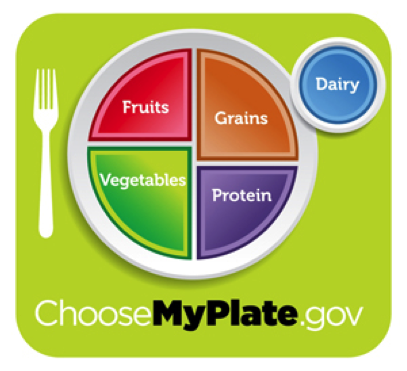 A new food guide plate was launched in 2011 to provide individualized dietary recommendations based on the 2010 Dietary Guidelines for Americans. This replaces the previous Food Guide Pyramid.
A new food guide plate was launched in 2011 to provide individualized dietary recommendations based on the 2010 Dietary Guidelines for Americans. This replaces the previous Food Guide Pyramid.
These are general recommendation for an adult consuming 2000 calories per day.
|
 Grains: at least 3 oz. of whole-grain products (one slice of whole wheat bread = 1 oz.) Grains: at least 3 oz. of whole-grain products (one slice of whole wheat bread = 1 oz.)

Vegetables: at least 2½ cups of vegetables. Each week select from all 5 vegetable subgroups: dark green, orange, legumes, starchy vegetables, and others.
Fruit: at least 2 cups fruit
Milk: up to 3 cups low-fat or fat-free milk products
Protein: 5-6 oz of lean meats, beans, legumes, etc.
|
An important distinction to make here is the difference between portion size and serving size. People often consume a single portion that actually contains multiple servings. People's concepts of appropriate portion size have expanded over time (along with their waist line).
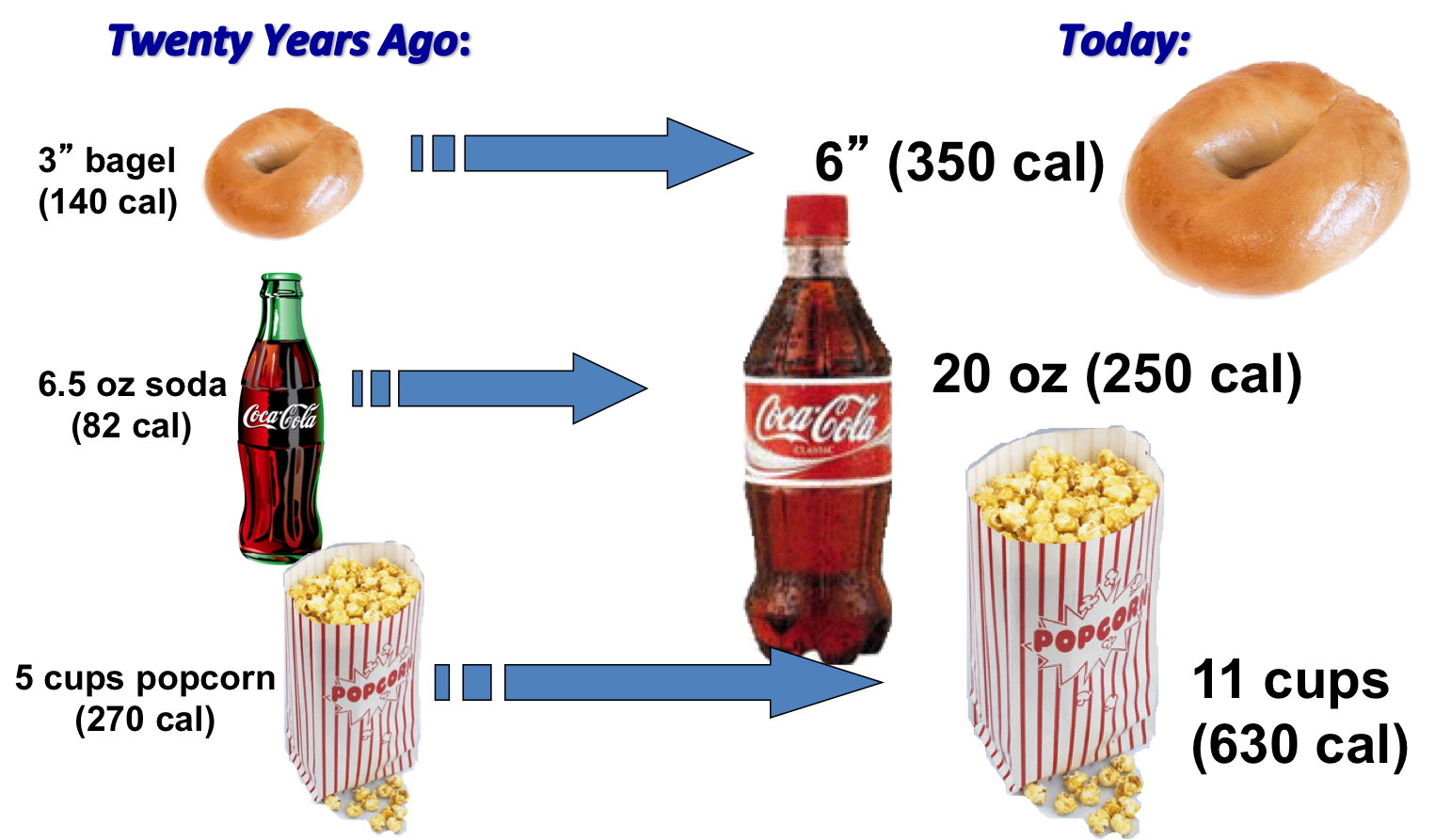
For More Information:
- Evidence-based lifestyle recommendations to promote health and prevent disease: Consumer Brochure
- Recommendations for specific groups such as children and pregnant women: Summary of 2010 Guidelines
- Recommended Dietary Plans to follow USDA Guidelines:
- DASH Eating Plan
- USDA's MyPlate
Basic Concepts
The fundamental goal, of course, is to promote health through a balanced, nutritious diet that balances calorie intake and calorie expenditure. A few basic definitions and reference points are important.
Nutrient-dense vs. Energy-dense Food
|
Nutrient-dense foods are characterized by a high amount of nutrients such as vitamins, calcium, fiber (e.g. mg/g, g/L):
- Fruits, vegetables, whole grains
- Fat-free or low-fat milk and milk products
- Lean meats, poultry, fish, beans, eggs, and nuts
Foods with added sugar or fat are usually not nutrient-dense.
|
Energy-dense food items are characterized by a high amount of calories (e.g. kcal/g, kcal/L):
- Chocolate
- French fries
- Regular sodas and alcoholic drinks
Most nutrient-dense foods are not energy-dense, but nuts are an exception.
|
Calorie Needs of Adults
The calorie needs or energy requirements for adults vary with age, gender, height, weight, level of physical activity, and medical/surgical conditions. Generally, the calorie requirements are higher in adults who are males, younger, and athletes.
The table below provides some general guidelines.
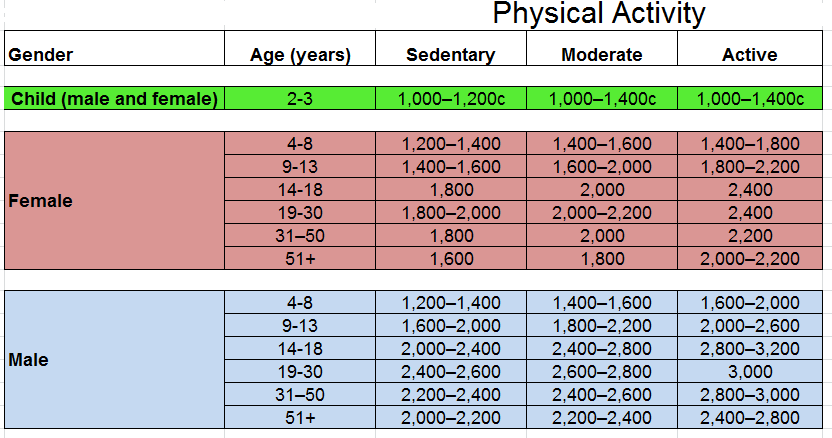
CDC Recommendations for Physical Activity
To improve overall health, maintain weight and reduce the risk for chronic disease, most American adults (ages 18-64) should get:
- 150 minutes of moderate activity per week (30 minutes 5 days per week) OR
- 75 minutes of vigorous activity per week (15 minutes 5 days per week) AND
- Engage in muscle strengthening activity 2-3 days per week
Recommendations vary for other populations including children, older adults, and pregnant women, and there are also separate recommendations for those looking to lose weight.
CDC Physical Activity Guidelines
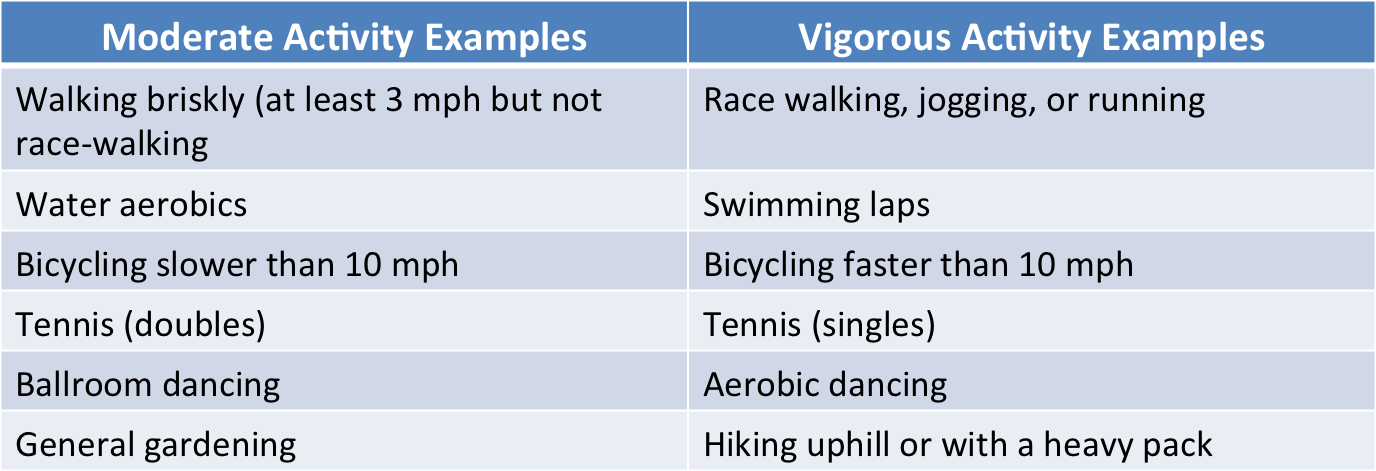
When discussing activity level with patients, it is useful to educate them about:
- Target Heart Rate
- Rating of Perceived Exertion Scale
These and other useful techniques can be found at: Measuring Physical Activity Intensity
Dietary Self-Assessment
A dietary self-assessment should include four basic elements:
- Pre-assessment Reflection
- BMI Calculation
- MyPlate 24-hour Recall
- Interpret Results and Set Goals
1. Pre-assessment Reflection
Before beginning your self-assessment, ask yourself how you perceive your health based on your weight/BMI and current dietary habits. Not surprisingly, physicians who have a higher awareness of their own diet are more likely to counsel patients about nutrition and the importance of achieving a healthy weight, and physicians who have intentionally altered their own diets are more likely to assist patients in making dietary changes.
2. BMI Calculation
BMI is an abbreviation for body mass index. This is a calculated measurement based on one's height and weight that is used as screening tool for body fat and to identify potential health risks. BMI is not an exact measure of body composition, and it can be misleading, for example, when used in professional athletes. However, it is a useful screening tool in the general population.
|
BMI = kg/m2
(or BMI = lbs/in2 x 703)
|
One can also use the widget below to calculate BMI in adults.
Once you have calculated BMI, the table below will provide a general classification scheme.
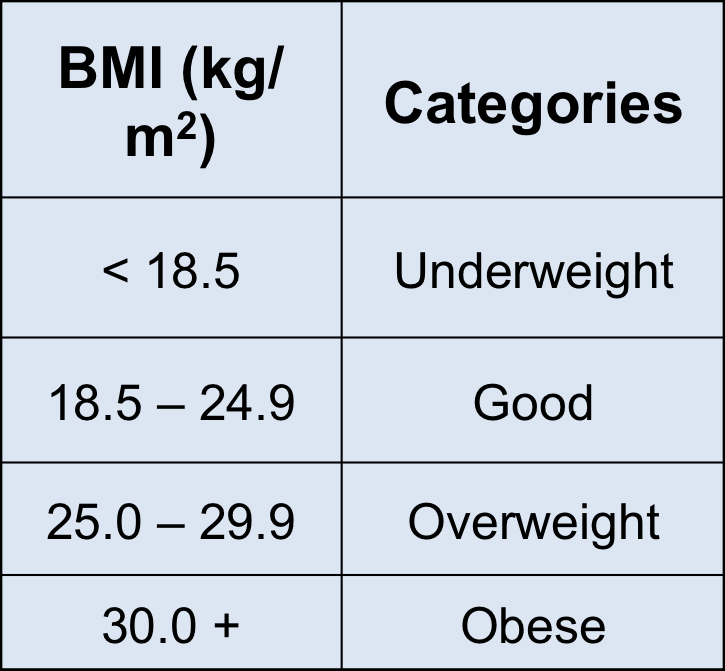
3. Healthy Plate Food Tracker
For this part of the assessment you will need to know:
- the types of all food and beverages (including milk, soda, juice and iced tea) you had in the past day (brand name may be helpful).
- the method of preparation (raw, cooked, with salt or with butter, etc.)
- the amount of each food eaten (i.e. cups, ounces, pieces etc.)
To start the recall:
- Go to SuperTracker Foodtracker https://www.supertracker.usda.gov/foodtracker.aspx
- Register as a new user or login with your user ID and password.
- Enter your age, gender, weight, height, and activity level.
- Click "Proceed to Food Intake."
To complete the recall:
- Foodtracker will break the day into snacks and 3 meals. Search the database for the foods (or ingredients) and beverages you consumed in the last 24 hours.
- Select each food, estimate the quantity of each item you select, and add it to the appropriate meal or snack. You will then see the item added to your 24-hour food recall.
- When you are finished, you will see the calorie breakdown for each meal, as well as the day, and the nutrient breakdown for the entire day.
The nutrient intake will be calculated and compared to your personal MyPlate recommendations and to the 2011 Dietary Guidelines. Suggestions for improving your diet will be included.
|
Tips for Completing the 24-Hour Recall
|
- Start with the first thing you ate when you woke up yesterday morning and work through the day.
- Remember to include ALL beverages and snacks.
- Remember the difference between a serving and a portion. The quantity selected should reflect what you actually consumed.
If you do not find the exact food item you ate:
- Select a generic version: e.g. in place of Smucker's strawberry jam, choose "JAM, PRESERVES, ALL FLAVORS."
- If no generic version exists, choose an alternate item similar to that you ate: e.g., in place of cashew butter, choose "ALMOND BUTTER."
- For mixed dishes, break the food down into its separate components (ingredients): e.g. for a basic vinaigrette dressing, choose "OLIVE OIL" and "VINEGAR" , plus any salt/pepper or other flavorings in the dressing. Provide ingredients found in casseroles, homemade soups, sandwiches, & toppings
|
Estimating Portion Size
Here are some helpful conversion factors.
1 cup = 16 Tablespoons
1 Tablespoon = 3 teaspoons = 1/16 cup = 0.0625 cups
1 teaspoon = 0.33 Tablespoon = 0.02 cups
And here are some easy ways to estimate portion sizes:

All portions above are based on one standard serving. If the cereal in your bowl looks like 2 fists, count it as 2 cups in the tracker.
4. Interpreting Your Results
Using the tracker is a great starting point to analyze your dietary intake, but remember:
- There are limitations of the food database (e.g., not having certain food items or dietary supplements)
- Difficulty in remembering or estimating portions eaten may affect the accuracy of the analysis.
- If the past 24 hours were not a typical day for you, your analysis may not reflect the quality of your overall diet.
Therefore, use your results as a general guideline. For a more accurate analysis, try measuring and recording your intake at meals and using the tracker for multiple days.
Next Steps
The next step is to honestly consider the results of the 24-hour recall and the recommendations and to review the basic information presented in the beginning of this module. What have you learned from the analysis and the recommendations?
Set short- and long-term achievable goals and make some healthy changes. Rather than making severe changes in your diet, consider where modest changes could be made to provide you with healthier meals. Also consider the guidelines for physical activity. Again, instead of making severe changes that are not sustainable, think about your typical daily activities and try to come up with a workable plan that will increase your activity. Little additions in activity can really add up, for example, parking farther at the far end of a parking lot instead of trying to get the closet spot to your destination. Try to add time for activities that you enjoy - anything that gets you moving - biking, walking, golf, gardening....
Remember also that Registered Dietitians can provide valuable help, particularly if you are confused about what changes to make in order to improve your nutrition. Dietary assessments are useful for initial evaluations and a great way for you to start a conversation about diet and exercise habits. Patients with diet-related concerns or conditions should be referred to a Registered Dietitian for a thorough assessment and continuing care.
Additional Resources
- More from USDA http://ww.nutrition.gov
- American Dietetic Association http://www.eatright.org
- Centers for Disease Control & Prevention (CDC) Nutrition http://www.cdc.gov/nutrition/
- The DASH Eating Plan http://www.nhlbi.nih.gov/hbp/prevent/h_eating/h_eating.htm
- Sparkpeople http://www.sparkpeople.com
- American Diabetes Association http://www.diabetes.org/food-nutrition-lifestyle/nutrition.jsp
- Food and Nutrient Databases
- http://www.CalorieKing.com
- http://www.NutritionData.com
- http://www.Peapod.com


 Every five years the Department of Health and Human Services (HHS) and the Department of Agriculture (USDA) issue a report containing nutritional and dietary information and guidelines for the general public over two years of age based on a review of scientific evidence. The aim is to provide advice to promote health and to reduce risk for major chronic diseases through diet and physical activity. A detailed description of the process and the most recent report can be found at http://www.health.gov/dietaryguidelines/2010.asp
Every five years the Department of Health and Human Services (HHS) and the Department of Agriculture (USDA) issue a report containing nutritional and dietary information and guidelines for the general public over two years of age based on a review of scientific evidence. The aim is to provide advice to promote health and to reduce risk for major chronic diseases through diet and physical activity. A detailed description of the process and the most recent report can be found at http://www.health.gov/dietaryguidelines/2010.asp A new food guide plate was launched in 2011 to provide individualized dietary recommendations based on the 2010 Dietary Guidelines for Americans. This replaces the previous Food Guide Pyramid.
A new food guide plate was launched in 2011 to provide individualized dietary recommendations based on the 2010 Dietary Guidelines for Americans. This replaces the previous Food Guide Pyramid.



